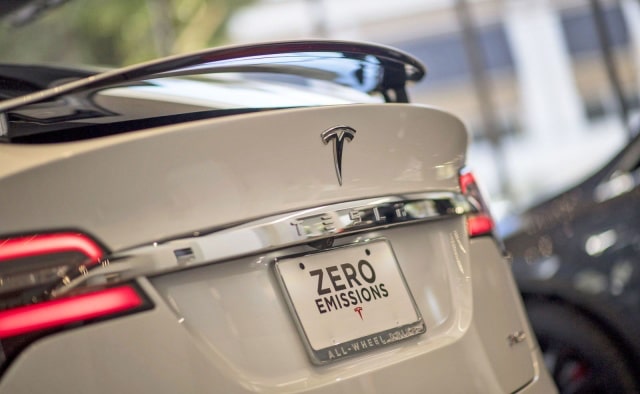The Future of Transportation: Zero Emission Vehicles

David Paul Morris/Bloomberg via Getty Images
Electric vehicles are often dubbed “zero-emission.” You’ve probably seen the phrase sported on the back of a new Tesla. But is an entire electric vehicle fleet really zero emissions? In this article, we will dig into what it means for a vehicle to be zero emissions, and how electric vehicle drivers can go beyond zero-emission to truly decarbonize their transportation.
Are Electric Vehicles Really Zero Emission?
The short answer is yes. An electric vehicle does not have tailpipe emissions or an exhaust system, so zero emissions are coming from the back of an EV. This means they do not emit local pollutants such as volatile organic compounds, hydrocarbons, carbon monoxide, ozone, and lead.
And yet, a car’s energy must come from somewhere. In most cases, electric cars pull energy from the power grid, just like any appliance in your home. In this scenario, the amount of carbon emissions required to power an electric vehicle depends on two things: 1) The efficiency of the engine and 2) The electricity mix provided by the local power operator.
When it comes to efficiency, traditional internal combustion engines (ICE) don’t hold a candle to battery-powered engines (BPE). BPEs are over 4X more efficient than ICEs. They convert between 60 – 77% of the energy available, compared to gas cars, which only convert 21 – 40% of the available energy. This fact alone makes EVs much cleaner than a traditional vehicle. Given these efficiency advantages, the average EV in the US produces global warming pollution equal to a gasoline vehicle that gets 88 miles per gallon fuel economy. That’s significantly better than the most efficient gas car available in the United States, which gets 58 miles to the gallon.
Now let’s consider the second factor in determining the carbon emissions of an EV: the electricity mix of powering the vehicle. What we mean by electricity mix is the mix of electricity sources powering the electric grid in your community. Depending how much renewable energy is in that mix, an electric car’s emissions will vary. Nationally, the US gets around 17% of its energy from renewables, a number that is increasing steadily. And in some regions of the US, the grid is already extremely clean. For instance, Washington state, which relies heavily on hydropower as an electricity source, gets around 90% of its electricity from renewable resources. The more renewables you have in your local electricity mix, the cleaner your electric vehicle will be. Many utilities and cooperatives now offer options enabling their customers to choose whether to source all or a percentage of their electricity from renewable sources.
Two Ways to Drive Even Cleaner
We’ve established that EVs are much cleaner to drive than a traditional gas car, but if you want to minimize your ecological footprint as much as possible (which we highly encourage!), there are two ways you can eliminate the emissions associated with your transportation:
1) Power your car with onsite renewables
Some EV drivers have rooftop solar that powers their home and EV charging. If your solar is sized sufficiently to power your electric vehicle, you can truly claim that your transportation is zero emission.
2) Power your car with JuiceEco
We worked closely with our sustainability and product development team to develop JuiceEco, a new way for EV drivers to match the energy consumption of their electric vehicle with renewable energy from Renewable Energy Certificates (RECs). With a small investment ($30/year for a person that drives 10,0000 miles), you can purchase a 3400-kWh certificate that will help add more renewable energy to the grid and gets credited towards your vehicle’s energy consumption. The result? Zero emission driving.
A Word on the Future
The grid gets cleaner every day. As a result, every EV on the road produces fewer emissions than it once did.
The percentage of electricity generated from coal decreased from 2008 to 2018 in 49 states. Notably, California (which is home to the most EVs) passed its 33% renewable energy target two years before the 2020 deadline. The state’s next renewable milestone is 44% renewables by 2024 and 60% by 2030.
These trends bode well as California is set to increase EV adoption to 100 percent by 2040, and ban gas car sales by 2035. The state’s Zero-Emission Vehicle (ZEV) mandate and gas car sales ban will ensure a shift to battery-powered vehicles. Nearly 20 other states follow the same ZEV rules.
By the time EVs start to dominate our roadways, the vast majority of electricity used to charge them will be delivered from renewable sources. We’re looking forward to a future where all emissions – whether from transportation, buildings, or power generation – come out to net zero.


